Abstract
With the rapid increase in municipal solid waste and the associated production of incineration fly ash (IFA) in Taiwan, sustainable utilization of industrial by-products has become a pressing concern. This study evaluates the mechanical, environmental, and structural performance of ultra-high-performance concrete (UHPC) incorporating water-quenched slag (WQS) and IFA as partial replacements for cement or quartz powder. Laboratory-scale specimens were tested for compressive and flexural strength, followed by full-scale load-bearing tests on trench covers (60 × 35 × 4 cm) and manhole covers (120 × 60 × 5 cm) with varying steel fiber contents and welded steel mesh reinforcement. Mechanical behavior, heavy-metal leaching (TCLP), carbon emissions, and life cycle impact assessment (LCIA) were examined. The results show that WQS maintained or enhanced strength, while IFA caused strength loss and surface corrosion due to gas release during hydration. Trench covers with 15% WQS achieved the highest peak load (14,733 kg), exceeding heavy-traffic requirements, whereas IFA-based covers met the 10-ton standard but showed corrosion. Manhole covers did not reach the 75-ton design load, indicating applicability only for light or non-traffic areas. All UHPC mixes immobilized heavy metals within regulatory limits, and partial cement replacement reduced the carbon footprint by 60–120 kg CO2e/m3. LCIA further indicated that 20% IFA replacement provided the greatest overall environmental benefit. In conclusion, WQS-incorporated UHPC offers reliable structural and environmental performance, while IFA requires pretreatment or modification to ensure long-term durability.
1. Introduction
In recent years, rapid industrial and economic development has led to accelerated urbanization and an increasing demand for construction materials, particularly steel and high-performance concrete. The continual rise in steel prices, especially in Asia, has resulted in the frequent theft of cast iron products such as manhole covers, posing serious public safety risks. At the same time, municipal solid waste management has become a pressing environmental concern. Although the government has constructed numerous waste incineration facilities over the past decade, Taiwan still generates approximately 10 million metric tons of waste annually. While incineration effectively reduces the volume of waste, it produces a substantial amount of incineration ash—about 15% of the original waste volume—of which fly ash remains especially problematic due to its high content of heavy metals and toxic substances such as dioxins. Without proper treatment, this fly ash poses a risk of severe secondary pollution. Finding ways to reduce and reuse incineration fly ash is therefore an urgent challenge [1,2].
Municipal solid waste incineration generates two types of ash: bottom ash and fly ash. Bottom ash, characterized by a larger particle size and lower concentrations of heavy metals and soluble salts, generally meets the regulatory limits set by the Environmental Protection Administration (EPA) and is thus classified as general industrial waste suitable for resource reuse [2,3]. In contrast, fly ash, with finer particle sizes, is collected by air pollution control devices and contains high concentrations of toxic heavy metals such as lead and zinc, as well as soluble salts, often exceeding hazardous waste thresholds and thus classified as hazardous waste [3]. Tay [4] reported that fly ash predominantly falls within the clay-size range (86%), with only a small portion in the sand-size fraction (14%), which is influenced by incinerator conditions such as combustion temperature, operating parameters, and APC (air pollution control) system type.
Heavy metal concentrations in fly ash are strongly correlated with particle size—smaller particles tend to contain higher levels of heavy metals [5,6,7]. For instance, Pb content increases with surface area, and is positively correlated with the chlorine and carbon contents [8,9]. According to IAWG [5], elements such as Ca, K, Na, and Cl are predominantly retained in fly ash after incineration, especially volatile heavy metals like Pb, Zn, and Cd, which condense on fly ash surfaces after volatilization. Furthermore, the chemical composition of fly ash varies depending on the waste composition, incinerator design, and the flue gas treatment method (e.g., wet or dry scrubbers, addition of Ca(OH)2 or activated carbon). The high content of alkali metals like K and Na in fly ash may pose durability concerns when used in cement-based materials [10].
Several stabilization and solidification techniques—such as cement-based solidification, chemical treatment, plasma vitrification, and wet chemical processes—have been developed for treating incinerator fly ash, each with specific advantages and limitations, as summarized in Table 1. Among these, the ideal treatment method should aim to (1) completely eliminate dioxins and prevent their reformation; (2) recover heavy metals to avoid secondary leaching; (3) reduce the waste volume to zero, eliminating the need for landfilling; (4) produce valuable end products with broad applicability; (5) avoid secondary pollution and emissions during treatment; and (6) provide environmental, ecological, and energy-saving benefits [1,2]. In this context, the dense matrix and high binding capacity of UHPC offer a promising platform for the encapsulation and immobilization of hazardous constituents in incineration fly ash, potentially integrating environmental safety with advanced construction performance [11,12].

Table 1.
Comparison of intermediate treatment technologies for municipal waste incineration fly ash.
IFA and WQS are potential by-products that can be reused as partial replacements for cement or quartz powder in concrete materials. While numerous studies have explored the incorporation of such materials in ordinary concrete, their application in UHPC remains in the exploratory stage. Effective utilization of these industrial by-products could reduce carbon emissions, lower material costs, and promote resource recycling. However, due to the high concentrations of hazardous heavy metals in IFA, direct landfilling without proper intermediate treatment can result in significant leaching risks. The environmental impact of heavy metals varies depending on their chemical forms, mobility, and origin. Therefore, pretreatment is essential to stabilize these metals and prevent ecological harm [10].
Dioxins in waste fly ash are highly toxic, and improper treatment poses serious safety risks. In the study by Yajun Lv et al. [13], high-temperature treatment reduced dioxin levels to 1/1209 of the original. When 20% of cement was replaced with treated MSWI fly ash, UHPC showed faster hydration, lower fluidity, shorter setting time, and improved 28-day compressive strength. The treated fly ash also produced harmless pores (<20 nm) and effectively bound heavy metals, indicating its potential as a cement substitute in UHPC. Lee et al. [14] also showed that adding incinerator fly ash to UHPC supports recycling and carbon reduction without harming its mechanical performance, indicating practical application potential.
UHPC is known for its outstanding compressive and flexural strength, extremely low porosity, and superior durability. It has been widely applied in infrastructure such as bridges, roadways, and structural reinforcement [15,16,17]. These superior properties result from the use of fine powders and a low water-to-binder ratio, making UHPC highly sensitive to the quality and characteristics of its constituent materials. Therefore, when incorporating alternative materials such as IFA or WQS, it is crucial to evaluate their effects on workability, mechanical behavior, and long-term durability. In addition, the chemical stability and heavy metal leaching potential of such waste-based materials are essential environmental assessment criteria [14,18].
UHPC exhibits exceptional ductility—up to 250 times greater than that of conventional concrete—which, along with its extremely low permeability, makes it resistant to chemical attack and ideal for use in aggressive environments [19,20,21,22]. According to Lee et al. [14], UHPC also demonstrates excellent bonding strength, dynamic modulus, and durability, making it suitable for structural repair and strengthening. Moreover, its dense matrix gives UHPC strong solidification capability, suggesting its potential for encapsulating toxic substances effectively.
On the other hand, WQS, a by-product of thermal plasma gasification technology used for municipal solid waste (MSW) treatment, has emerged as a promising sustainable material. In this high-temperature process, organic matter is converted into syngas, while inorganic residues are vitrified into inert slag. This slag retains most of the heavy and alkali metals present in the original waste and can be used as a construction material [12,18].
Therefore, this study investigates the effects of incorporating various replacement ratios of IFA or WQS into UHPC as partial substitutes for quartz powder or cement. After 28 days of curing, mechanical and load-bearing tests were conducted on both laboratory specimens and full-scale trench and manhole cover products to assess their performance under practical conditions. This roadmap helps readers follow the structure and purpose of the research.
2. Experiments
The primary objective of this study is to investigate the effects of incorporating different replacement ratios of IFA or WQS into ultra-high-performance concrete (UHPC) as partial substitutes for quartz powder or cement. Basic mechanical tests were conducted, and after the specimens reached 28 days of curing, loading tests were performed. In addition to laboratory-scale specimens, two types of trench cover and manhole cover products were fabricated using selected UHPC mixtures and subjected to standardized load-bearing tests in order to evaluate their applicability under practical service conditions. The study aims to explore the relationship between the replacement percentage of IFA or WQS and the resulting strength, thereby determining the optimal replacement content for both structural performance and product-level applications.
2.1. UHPC Materials and Mixtures
The test specimens in this study were made using ultra-high-performance concrete (UHPC). The primary materials and mixtures included water, cement, silica sand, silica fume, quartz powder, superplasticizer, defoaming agent, and steel fibers. The key variable in the experiment was the partial replacement of quartz powder or cement with either incinerator fly ash (IFA) or water-quenched slag (WQS), as shown in Table 2. WQS and IFA are distinct supplementary materials—WQS is a by-product of molten slag rapidly cooled by water, while IFA is a fine particulate residue collected from municipal solid waste incineration. The UHPC mix designs included two different series of samples: one series incorporated WQS and the other incorporated IFA as partial replacements, rather than a combined mixture of both materials. The variable in each group was the substitution ratio of quartz powder or cement, which was replaced by IFA or WQS by weight (10%, 15%, and 20% levels). This systematic variation allows for a direct comparison between the control group and the modified mixtures to determine the optimal replacement level in terms of mechanical performance and material sustainability.

Table 2.
UHPC mix proportions with partial replacement of quartz powder or cement by WQS or IFA (kg/m3).
The UHPC used in this experiment incorporated Type II Portland cement (moderate heat cement) produced by Taiwan Cement Corporation. Type II Portland cement generates a lower heat of hydration and has a slower heat release rate compared to Type I Portland cement. It also offers resistance to moderate sulfate attack, making it suitable for mass concrete structures. In Taiwan’s highly corrosive environment, the sulfate resistance of Type II cement enhances the durability of materials. The chemical composition and properties of the cement are shown in Table 3 [14].

Table 3.
Composition and properties of Portland cement.
The silica fume used in this study was produced by Sanlin Trading Co. (Taichung, Taiwan) and had a particle size ranging from 0.1 to 1 μm. Its chemical composition and physical properties are shown in Table 4. The main component is silicon dioxide (SiO2), which accounts for approximately 90%.

Table 4.
Chemical composition and physical properties of silica fume.
Quartz powder not only promotes the formation of C-S-H gel through the reaction with calcium hydroxide (CH), but also enhances the strength of ultra-high-performance concrete (UHPC) after high-temperature curing. The quartz powder used in this study was produced by Chih Chun Industrial Co., Ltd. (Taipei, Taiwan) and had a particle size ranging from 5 to 20 μm. The optimal addition amount of quartz powder is generally 15–35% by weight of cement [1]. The silica sand used in this study was also produced by Chih Chun Industrial Co., Ltd., model #3. The particle size distribution obtained from sieve analysis is shown in Table 5. The fineness modulus (F.M.) of 2.54 indicates that the silica sand has a medium-fine grading, suitable for achieving dense particle packing in UHPC mixtures.

Table 5.
Sieve analysis results of silica sand.
A high-range water-reducing admixture imported from Japan, produced by TAKEMOTO OIL & FAT Co., Ltd. (Gamagori, Japan), was used in this study. The product model is CHUPOL SSP104 and had a solid content of 30%. It functions effectively as a water-reducing agent. The main chemical component is an anionic surfactant based on acrylic acid graft copolymer, with a specific gravity ranging from 1.07 to 1.13.
The WQS (water-quenched slag) is a vitrified material composed of inorganic components from the CaO–SiO2–Al2O3 system. The major crystalline phases in this system are anorthite (CaO·Al2O3·2SiO2) and wollastonite (CaO·SiO2), both of which are needle-like crystals. These crystals interweave in a complex pattern within the glassy matrix, resulting in high strength, making the material highly suitable for use in civil engineering and construction. The properties of the molten slag can be classified according to its cooling method into air-cooled (dry) slag and water-cooled (quenched) slag.
In this study, all WQS used was ground to pass through a #200 sieve. The results of the toxicity characteristic leaching procedure (TCLP) for the WQS (unit: mg/L) are shown in Table 6, and the chemical composition analysis is shown in Table 7.

Table 6.
TCLP results of water-quenched slag (Unit: mg/L).

Table 7.
Chemical composition analysis of water-quenched slag.
The study obtained the toxicity characteristic leaching results (unit: ppm) and chemical properties of municipal solid waste incineration fly ash from Hsinchu and Beitou, as shown in Table 8 and Table 9. According to the data, incineration fly ash exhibits high alkalinity. The particle size distribution of the fly ash is comparable to coarse fine aggregate. Due to its porous nature, the fly ash has a lower specific gravity and significantly higher water absorption than conventional aggregates. All incineration fly ash used in this study was ground to pass through a #200 sieve. The chemical composition of water-quenched slag (Table 7) and incineration fly ash (Table 9) was determined using X-ray fluorescence (XRF, PANalytical Axios, National Central University, Taoyuan, Taiwan). The concentrations of heavy metals presented in Table 6 and Table 8 were obtained through the Toxicity Characteristic Leaching Procedure (TCLP) in accordance with U.S. EPA Method 1311 [23], followed by analysis using Inductively Coupled Plasma Optical Emission Spectroscopy (ICP-OES, PerkinElmer Optima 8000, National Taiwan University, Taipei, Taiwan).

Table 8.
TCLP results of incineration fly ash from Hsinchu and Beitou (unit: ppm).

Table 9.
Chemical composition of incineration fly ash from Hsinchu and Beitou.
2.2. Test Method and Concrete Samples
The main testing items in this study involved utilizing the material characteristics of water-quenched slag and incineration fly ash to replace quartz powder or cement in UHPC. The test specimens included 4 cm × 4 cm × 16 cm prismatic specimens and Φ5 cm × 10 cm cylindrical samples. Basic mechanical tests were conducted, along with heavy metal content analysis within the specimens. By evaluating the strength variations in the UHPC, the optimal replacement ratio and the most suitable type of incineration ash residue were determined, aiming to reduce production costs and achieve the goal of resource reuse.
The compressive strength tests of cylindrical UHPC specimens were conducted in accordance with ASTM C39/C39M [24]. Flexural performance of prismatic specimens followed ASTM C1609/C1609M [25] for fiber-reinforced concrete. The chemical composition of the incineration fly ash and molten slag was analyzed according to ASTM C114 [26], and heavy metal contents were examined following EPA Method 1311 (TCLP).
In addition to laboratory-scale specimens, two types of cover products were fabricated, namely trench covers (60 × 35 × 4 cm) and manhole covers (120 × 60 × 5 cm), as summarized in Table 10. The number of specimens prepared for each mix test included three cylindrical specimens, three prismatic specimens, three trench covers, and two manhole covers. Each cover was produced using selected UHPC mixtures with steel fibers at volume fractions of 0%, 1.5%, 2.5%, and 3.5%. To further enhance the toughness and load-bearing capacity, welded 6 mm wire mesh or #4 steel mesh was embedded at thicknesses ranging from 2.0 cm to 3.0 cm. The load-bearing test procedure, including equipment, boundary conditions, and load application points, followed the method reported by Lee et al. [14]. Finally, full-scale load-bearing tests were conducted to evaluate the structural performance and service applicability of these UHPC-based cover products.

Table 10.
Summary of specimens, test methods, and parameters.
Fibers are incorporated into concrete to mitigate shrinkage-induced surface cracking and provide tensile resistance under compression, thereby delaying crack initiation and propagation. In this study, ultra-high-performance concrete (UHPC) incorporating 2.5% steel fibers by volume was evaluated for mechanical performance with partial cement replacement by IFA or WQS at 0%, 10%, 15%, and 20% by weight. Cylindrical specimens (Φ5 cm × 10 cm) were tested in compression, and prismatic specimens (4 cm × 4 cm × 16 cm) in flexure. After demolding, the UHPC specimens were placed in a high-temperature steam curing cabinet at a constant temperature of 90 °C for four days to accelerate hydration and decomposition reactions within the concrete, as shown in Figure 1. Subsequently, the specimens were oven-dried at 90 °C for two days (Figure 2), followed by immersion in a saturated limewater curing tank at room temperature. All tests were performed after the specimens reached 28 days of age. High-temperature curing was employed to refine the UHPC microstructure, enhance the early-age strength, and assess the strength development using varying fly ash replacement levels.
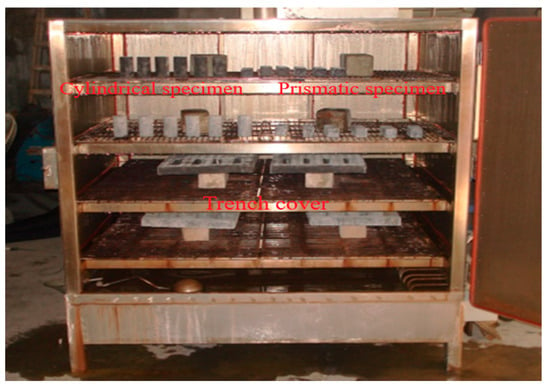
Figure 1.
UHPC specimens during high-temperature steam curing.
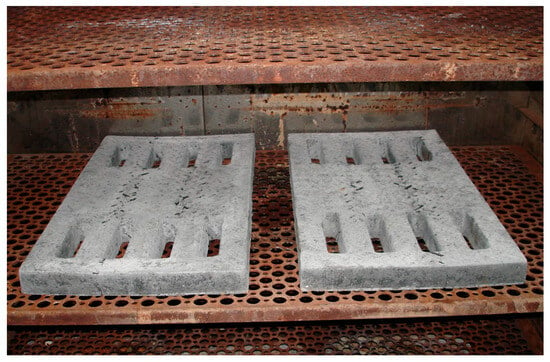
Figure 2.
UHPC specimens during oven-dried curing.
2.3. Analysis of the Heavy Metals in Leachate
Analysis of the heavy metals in the leachate was conducted following the TCLP method (EPA Method 1311) to evaluate the environmental suitability of incineration residues [23]. The reuse potential of incineration bottom ash depends largely on its heavy metal content. If the leachate concentrations obtained through the Toxicity Characteristic Leaching Procedure (TCLP) are below national environmental standards, the material may be considered suitable for recycling. Therefore, accurate heavy metal analysis is essential.
In this study, TCLP was conducted on bottom ash samples, and the leachate was analyzed for its heavy metal contents. Most analyses were performed using atomic absorption spectroscopy (AAS), while lead (Pb) was also tested using the Merck Nova 60 (Chung Hua University, Hsinchu, Taiwan), a portable spectrophotometric device. Compared to AAS or ICP-AES, the Nova 60 offers faster and more convenient testing using reagent kits, making it suitable for on-site applications. The lead detection procedure using the Merck Nova 60 is as follows [27]:
- a.
- Prepare the lead test kit.
- b.
- Adjust leachate pH to 3–6 using ammonia or nitric acid.
- c.
- Measure total hardness:
- ○
- If <70 mL, proceed with Step A only.
- ○
- If ≥70 mL, perform Steps A and B.
- Step A: Add 5 drops of reagent PK-1 and 5 mL of leachate. Mix.
- Insert tube into the Nova 60 and record Reading A, as shown in Figure 1.
- Step B: Add one scoop of PK-2 to the same tube. Mix.
- Insert again and record Reading B.
- d.
- Final concentration:
- ○
- If hardness < 70 mL → result = A;
- ○
- If hardness ≥ 70 mL → result = A – B.
3. Experimental Results and Discussion
3.1. Compressive Strength Test
Figure 3 and Figure 4 present the 28-day compressive strengths of UHPC incorporating incinerator fly ash (IFA) or water-quenched slag (WQS) as partial replacements for quartz powder and cement. When WQS replaced quartz powder, the strength declined from 128.4 MPa (0%) to 57.6 MPa (20%), with the minimum loss being 10% but a sharp reduction occurred at 20%, suggesting 15% as an upper limit. Replacement of cement with WQS produced lower strengths overall, reaching 66.8 MPa at 20%.
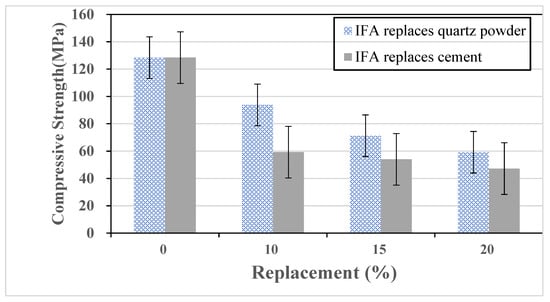
Figure 3.
Compressive strength of UHPC with incinerator fly ash (IFA) at 28 days.
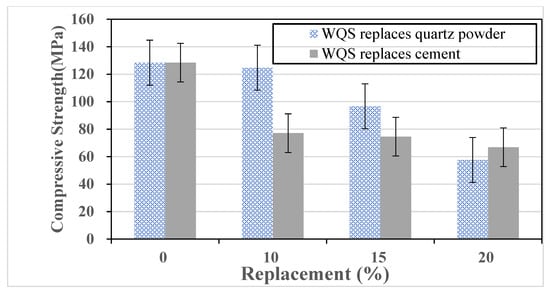
Figure 4.
Compressive strength of UHPC with water-quenched slag (WQS) at 28 days.
Figure 5 shows the 28-day compressive strengths of UHPC in which quartz powder was partially replaced with IFA from the Hsinchu and Beitou plants. For the Hsinchu plant, the strengths at 10%, 15%, and 20% replacement were 93.82 MPa, 71.27 MPa, and 59.17 MPa, respectively. For the Beitou plant, the corresponding values were 127.95 MPa, 114.51 MPa, and 108.68 MPa, indicating a less pronounced strength reduction than that of the Hsinchu plant. The greater strength loss in the Hsinchu series may be related to its elevated cadmium (4.083 ppm) and extremely high zinc (175.7 ppm) contents, whereas the Beitou fly ash exceeded the permissible limit for lead (31.246 ppm). Previous studies have reported that MSWI fly ash, after high-temperature treatment, can be used in UHPC to accelerate hydration, immobilize heavy metals, enhance compressive strength, and reduce the leaching of harmful substances. A review also noted that in UHPC without superplasticizers, FA replacement levels of up to 60% did not cause significant strength loss, while with superplasticizers, optimal performance was often observed at 20–35% replacement. However, these studies mainly examined the mechanical effects of IFA replacement and did not explore the impact of variations in heavy metal content on strength [14].
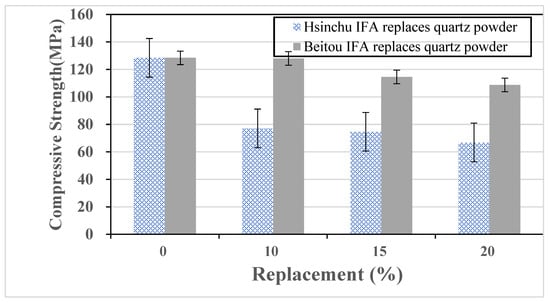
Figure 5.
Compressive strength of UHPC with incinerator fly ash (IFA) from Hsinchu and Beitou at 28 days.
3.2. Flexural Strength Test
In general, higher fiber dosages can enhance the compressive and flexural strength of concrete specimens. Figure 6 and Figure 7 present the 28-day flexural strengths of UHPC (with 2% fiber dosage) in which quartz powder or cement was partially replaced with incinerator fly ash (IFA) or water-quenched slag (WQS). When WQS replaced quartz powder, strengths declined from 35.61 MPa (0%) to 27.92 MPa (20%), with only a slight decrease at 10% but a sharp drop at 20%, suggesting 15% as a practical upper limit. In contrast, replacing cement with WQS yielded lower strengths overall (20.95 MPa at 20% replacement). IFA substitutions produced similar downward trends, with more pronounced losses when replacing cement. Overall, WQS outperformed IFA; however, at 10% quartz powder replacement, both materials produced comparable strengths, indicating a possible performance equilibrium.
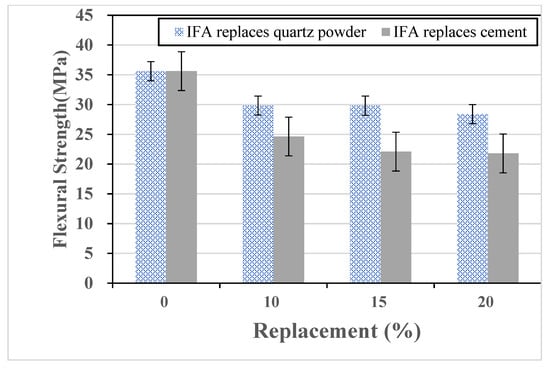
Figure 6.
Flexural strength of UHPC with incinerator fly ash (IFA) at 28 days.
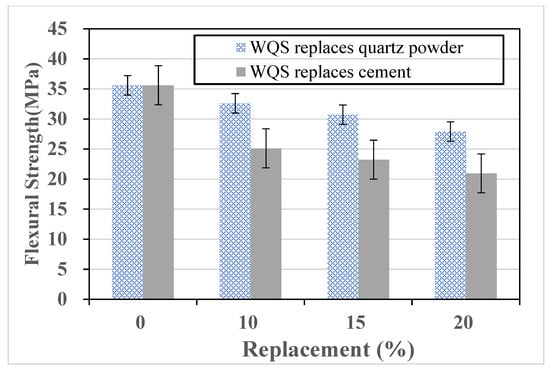
Figure 7.
Flexural strength of UHPC with water-quenched slag (WQS) at 28 days.
Figure 8 shows the 28-day compressive strengths of UHPC where quartz powder was replaced with IFA from the Hsinchu and Beitou plants. For Hsinchu IFA, the strengths with 10%, 15%, and 20% replacement were 25.12 MPa, 23.23 MPa, and 20.95 MPa, respectively. For Beitou IFA, the corresponding values were 34.35 MPa, 33.54 MPa, and 33.17 MPa, indicating a less severe reduction. The greater strength loss with Hsinchu IFA may be linked to its elevated cadmium (4.083 ppm) and extremely high zinc (175.7 ppm) contents, whereas Beitou IFA exceeded permissible limits for lead (31.246 ppm).
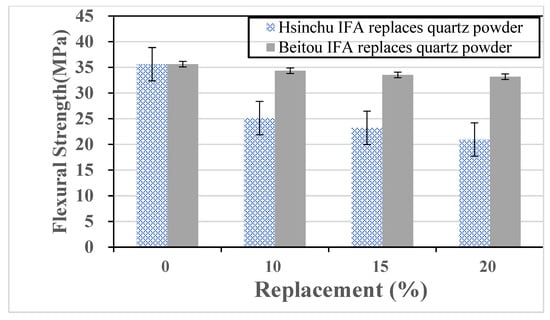
Figure 8.
Flexural strength of UHPC with incinerator fly ash (IFA) from Hsinchu and Beitou at 28 days.
High-temperature-treated IFA has been shown to accelerate hydration, immobilize heavy metals, enhance strength, and reduce leaching in UHPC. Without superplasticizers, up to 60% fly ash replacement may not markedly reduce strength; with superplasticizers, optimal performance occurs at 20–35%. However, most studies have focused on mechanical effects, overlooking the influence of the heavy-metal composition. The present results indicate that elevated zinc and cadmium contents may be a critical yet underexplored factor in UHPC performance when incorporating IFA [28,29].
3.3. TCLP Test
The TCLP results for both Hsinchu Plant IFA (Table 11) and Beitou Plant IFA (Table 12) confirm previous findings showing that UHPC possesses a dense microstructure capable of effectively immobilizing heavy metals present in incinerator fly ash. The TCLP standard values presented in Table 11 and Table 12 are based on the U.S. Environmental Protection Agency Toxicity Characteristic Leaching Procedure, Method 1311 [23]. Similar to the results of Zhang et al. [2] and Lee et al. [14], the present study demonstrates that replacing quartz powder or cement with IFA at 10–20% yields specimens with heavy metal concentrations well below the regulatory limits for hazardous industrial waste. In particular, Zn, Mn, Cu, Ni, and Cd in the Hsinchu series and Zn, Mn, Cu, Cr, Ni, Pb, and Cd in the Beitou series exhibited substantial reductions in leaching compared with their raw ash counterparts.

Table 11.
TCLP Heavy Metal Concentrations from Specimens (Hsinchu Plant IFA).

Table 12.
TCLP Heavy Metal Concentrations from Specimens (Beitou Plant IFA).
The pronounced decrease in Zn and Cd leaching from the Hsinchu IFA specimens (Zn: 175.7 ppm from raw ash; Cd: 4.083 ppm from raw ash) and the sharp reduction in Pb leaching from Beitou IFA specimens (Pb exceeding the standard by 31.246 ppm in raw ash) are consistent with the encapsulation effect of the UHPC matrix described by Shi et al. [22] in which the low permeability and high pozzolanic reactivity of UHPC binders enhanced the physical and chemical binding of heavy metals. This dense matrix limits pore connectivity, reduces ion diffusion pathways, and promotes stable mineral phase formation, thereby lowering both the mobility and the environmental risk of the contained metals.
3.4. Load-Bearing Test of Trench Covers and Manhole Covers
The full-scale load-bearing tests were conducted on two types of laboratory-scale UHPC products: trench covers (60 × 35 × 4 cm) and manhole covers (120 × 60 × 5 cm). The detailed loading configurations for the trench cover and the manhole cover tests are illustrated in Figure 9 and Figure 10, respectively. Each cover incorporated different steel fiber volume fractions (0%, 1.5%, 2.5%, and 3.5%) with and without welded steel mesh embedded at thicknesses ranging from 2.0 cm to 3.0 cm.
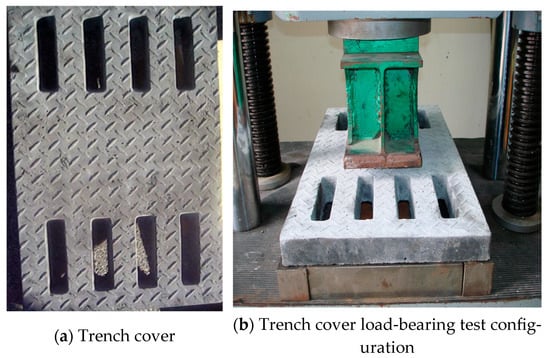
Figure 9.
Trench cover load-bearing test configuration.
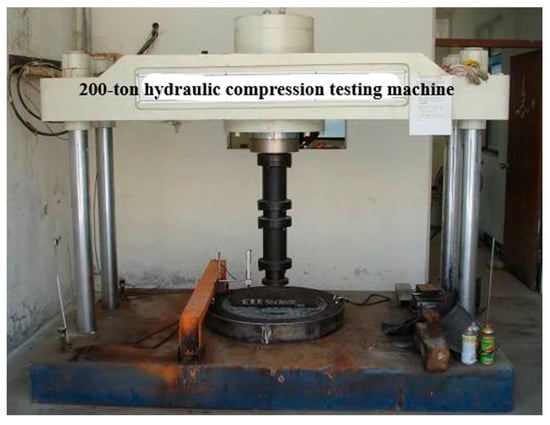
Figure 10.
Manhole cover load-bearing test configuration.
The load-bearing performance of the tested UHPC trench covers is summarized in Table 13. With 6 mm wire mesh, the load capacity increased from 3847 kg (0% fiber) to 7172 kg, 8119 kg, and 10,085 kg with 1.5%, 2.5%, and 3.5% steel fibers, respectively. With #4 welded steel mesh, capacity rose from 7376 kg to 12,476 kg, 14,345 kg, and 17,439 kg for the same fiber contents. Specimens without reinforcement and 0% fibers failed to reach the design load, while fiber additions (1.5–3.5%) progressively enhanced the load capacity and ductility, with the 3.5% mix exceeding heavy traffic requirements. Incorporating welded mesh further improved strength, toughness, and crack control, with the peak capacity reaching 17,439 kg (≈70% above design load). According to regulations, trench covers (60 × 35 × 4 cm) must withstand at least 10 tons of failure load, and the steel fiber–reinforced specimens with #4 welded mesh successfully satisfied this criterion (Figure 11).

Table 13.
Load Test Results of UHPC Covers.
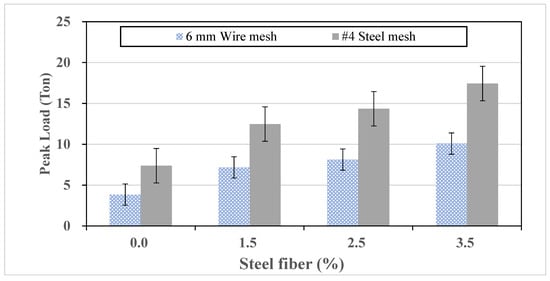
Figure 11.
Trench cover load test results.
Table 14 shows performance and cost-performance comparison of the trench covers in this study. The UHPC trench cover reinforced with 2.5% steel fibers met the 10-ton proof load requirement without cracking or excessive deformation. Compared with commercial products, FRP and cast iron covers provide similar load capacities, but UHPC achieves a much higher cost-performance (C/P) value (34.9%) while being lighter than cast iron and more durable than FRP. Unlike galvanized grating, which shows poor strength and short service life, UHPC combines high load capacity, corrosion resistance, and a projected service life exceeding 100 years, making it the most reliable and cost-effective solution among the evaluated trench covers [14,29].

Table 14.
Performance and cost-performance comparison of trench covers [14,29].
In contrast, the manhole covers in Table 13 exhibited lower overall load efficiencies. Despite the inclusion of steel mesh and up to 3.5% steel fibers, all tested configurations showed excessive displacements (33–47 mm). According to CNS 15536 [30], the national standard of the Republic of China, a manhole cover (120 × 60 × 5 cm) must withstand a static breaking load of 75 tons and exhibit a deflection of less than 10 mm under a 20-ton load. The experimental results clearly fell short of these criteria, indicating that the current UHPC manhole cover design is unsuitable for heavy traffic applications. The insufficient performance was mainly attributed to stress concentration and inadequate flexural stiffness under central loading [31]. The larger span-to-thickness ratio and discontinuity around the opening further reduced structural integrity compared with the trench covers. Such large deformations could pose safety risks for vehicles in service; therefore, the UHPC-based manhole covers are recommended only for areas with low traffic volume, no heavy vehicles, or non-traffic zones such as parks.
The typical failure pattern of UHPC trench covers under load testing is shown in Figure 12. When incineration fly ash (IFA) is incorporated into UHPC, large amounts of gas are released during the cement hydration process, leading to volumetric expansion and increased pore size within the hardened matrix. This results in higher permeability and, consequently, more pronounced surface corrosion on IFA-containing trench covers [14]. The cracking and spalling behavior of such specimens is illustrated in Figure 13. In contrast, trench covers incorporating water-quenched slag (WQS) exhibited more stable structural performance. Their failure mode was characterized primarily by ductile cracking with no obvious signs of corrosion.
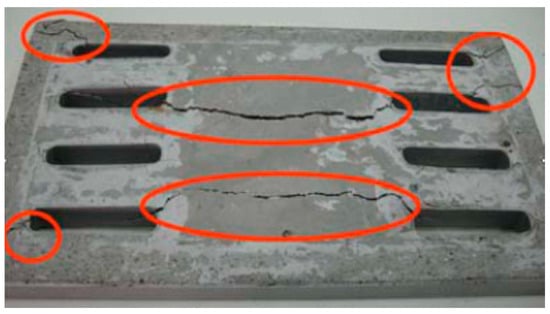
Figure 12.
Typical failure pattern of UHPC trench cover.
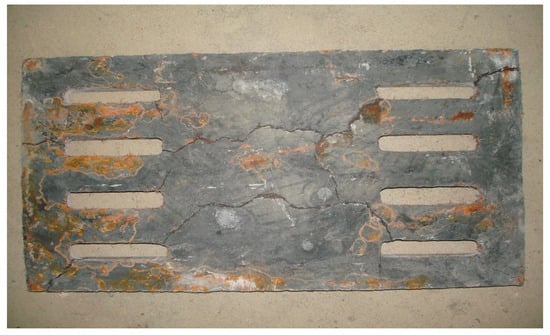
Figure 13.
Surface corrosion on IFA-containing trench cover.
By combining the test data in Table 15 with the observed failure phenomena, it can be concluded that WQS replacement maintained or even enhanced the load-bearing capacity of UHPC trench covers, with 15% quartz powder replacement achieving the highest peak load (14,733 kg) and exceeding the heavy traffic requirement. In contrast, IFA, although capable of meeting the 10-ton design load, exhibited pronounced corrosion and cracking due to gas release and pore expansion during hydration, indicating insufficient long-term durability and reduced reliability in practical applications. Overall, WQS can be regarded as a promising supplementary material for UHPC trench covers, whereas the use of IFA should be limited or subjected to pretreatment to mitigate expansion and corrosion problems.

Table 15.
Load Test Results of UHPC Trench Covers with Water-Quenched Slag and Incineration Fly Ash.
3.5. UHPC Life Cycle Impact Assessent
Table 16 summarizes the mix proportions and total carbon emissions (kg CO2e/m3) of UHPC incorporating either incineration fly ash (IFA) or waste quartz sand (WQS) as partial replacements for quartz powder or cement. The steel fiber content in all mixes was 2.5% by volume. The carbon emission factors used in this calculation were as follows: 1.10 kg CO2e/kg for steel fiber; 0.85 kg CO2e/kg for cement; 0.04 kg CO2e/kg for quartz powder; 0.008 kg CO2e/kg for silica sand; 0.40 kg CO2e/kg for silica fume; 4.00 kg CO2e/kg for the polycarboxylate superplasticizer (PCE); 2.00 kg CO2e/kg for the defoamer; 0.0003 kg CO2e/kg for water; 0.01 kg CO2e/kg for IFA; and 0.008 kg CO2e/kg for WQS. All emission factors were determined based on a cradle-to-gate system boundary, representing the total embodied carbon from raw material extraction through production and manufacturing, excluding transportation, construction, use, and end-of-life stages. The functional unit for the life-cycle impact assessment was 1 m3 of UHPC. The assessment followed the life cycle method proposed by Wang et al. [32]. Replacing 10–20% of cement with IFA or WQS significantly lowered the total carbon emissions, with a reduction of 60–120 kg CO2e/m3 compared to the control. For example, 20% cement replacement reduced emissions to ~836 kg CO2e/m3, demonstrating that substituting high-emission cement with low-emission materials is the most effective strategy for UHPC carbon reduction. As noted by Wang et al. study, replacing cement with high-volume SCMs is one of the most practical and economical approaches to reducing CO2 emissions [32].

Table 16.
UHPC mix proportions and total carbon emissions (kg CO2e/m3).
The life cycle impact assessment (LCIA) was conducted according to EN 15804+A2 (2019) [33], using EF 3.0 normalization and weighting, a widely adopted midpoint method for environmental product declarations. The selected impact categories include climate change, ozone depletion, human toxicity, acidification, eutrophication, ecotoxicity, and resource depletion. This framework enables quantification of environmental impacts—particularly global warming potential (GWP)—and supports comparative evaluations of UHPC mixture alternatives, thereby clarifying their sustainability implications [32]. Table 17 summarizes the life cycle environmental impacts of conventional UHPC and UHPC with partial replacement of cement or quartz powder by IFA or WQS. Replacing cement with IFA or WQS reduces the climate change impact (GWP) by approximately 6–13% (957.3 → 836.0–896.7 kg CO2-eq), while quartz powder replacement has minimal effects. Both substitutions decrease acidification and eutrophication potentials, especially cement replacement (acidification drops from 6.2 → 5.15 mol H+-eq at 20% IFA). Human toxicity impacts are slightly improved, and fossil and mineral resource depletion also decline with cement substitution (fossil: 8500 → 7055 MJ; minerals: 0.021 → 0.01806 kg Sb-eq).

Table 17.
Conventional UHPC and UHPC with WQS and IFA in different environmental impact categories and indicators (EN 15804+A2).
Cement replacement with IFA or WQS is far more effective in reducing environmental impacts than quartz powder replacement. Among all mixtures, 20% cement replacement with IFA achieves the lowest impact across nearly all categories, while quartz powder replacement provides only minor benefits. For example, 20% cement replacement with either IFA or WQS clearly outperforms conventional UHPC. These findings are consistent with the results reported in the Sustainability assessment of ultra-high-performance concrete made with various supplementary cementitious materials [34].
3.6. Comprehensive Analysis
Table 18 summarizes the overall performance of UHPC incorporating water-quenched slag (WQS) and incineration fly ash (IFA) as partial replacements for quartz powder and cement. In general, both IFA and WQS maintained acceptable leaching resistance (TCLP) across all replacement levels, confirming their potential for safe reuse. For mechanical properties, moderate strength retention was observed at 10–15% replacement levels, while 20% substitution—particularly for cement—led to significant reductions in compressive and flexural strength. WQS generally performed slightly better than IFA, though both showed convergence at low replacement levels.

Table 18.
Comprehensive analysis of UHPC Containing Water-Quenched Slag and Incineration Fly Ash.
From an environmental perspective, increasing the cement replacement ratio reduced carbon emissions and improved the sustainability index. Notably, replacing 20% of cement with IFA or WQS achieved the highest sustainability rating despite some mechanical drawbacks, whereas quartz powder replacement showed limited improvement due to unchanged cement content.
Overall, the comprehensive analysis suggests that moderate replacement levels (≤15%) balance strength and environmental performance, while higher cement replacement (20%) maximizes sustainability at the expense of mechanical properties. Thus, the optimal strategy depends on whether mechanical performance or environmental benefit is prioritized.
4. Summary
This study investigated the mechanical, environmental, and structural performance of UHPC incorporating water-quenched slag (WQS) and incineration fly ash (IFA) as partial replacements for cement and quartz powder, with a particular focus on trench and manhole cover applications. The main findings can be summarized as follows:
- Mechanical performance: Replacing cement or quartz powder with IFA or WQS reduced the UHPC compressive strength as the replacement ratio increased, with IFA causing greater reductions. Flexural strength was less affected, and UHPC with 10–15% IFA still met the 10-ton load requirement for trench covers.
- Source effects: The chemical composition of IFA influenced mechanical properties. Hsinchu IFA (high Zn and Cd) caused a greater strength loss than Beitou IFA (high Pb), emphasizing the importance of considering the heavy-metal content when designing UHPC mixes.
- Environmental performance (TCLP): All UHPC mixes immobilized heavy metals effectively, with Zn, Mn, Cu, Ni, Cd, Pb, and Cr leachates remaining below regulatory limits.
- Carbon emissions: Partial cement replacement with IFA or WQS reduced the UHPC’s carbon footprint by 60–120 kg CO2e/m3, with 20% replacement achieving ~836 kg CO2e/m3, demonstrating its potential as a sustainable strategy.
- Life Cycle Impact Assessment (LCIA): Cement replacement with IFA or WQS substantially reduced the global warming potential, acidification, and resource depletion, whereas quartz powder replacement yielded only minor environmental benefits. The most sustainable option was 20% cement replacement with IFA, which achieved the lowest overall impacts.
- Trench covers (60 × 35 × 4 cm): UHPC trench covers reinforced with steel fibers and welded #4 steel mesh exceeded the 10-ton design requirement, with the 15% WQS mix reaching 14,733 kg (heavy traffic standard). Although IFA-based covers met the strength criteria, durability concerns were noted. Overall, UHPC covers demonstrated the highest cost-performance (34.9%), a long service life (100+ yr), and superior reliability over commercial alternatives [33].
- Manhole covers (120 × 60 × 5 cm): None of the UHPC manhole covers satisfied the regulatory static load requirement of 75 tons. Excessive displacements (33–47 mm, vs. 10 mm limit under a 20-ton load) were observed, making them unsuitable for traffic applications. Such UHPC covers are only recommended for light traffic areas or non-traffic zones such as parks.
- Overall feasibility: UHPC incorporating WQS can be regarded as a promising material for trench covers, combining structural reliability with sustainability. IFA, although environmentally beneficial, requires pretreatment or modification to mitigate expansion and corrosion issues before reliable structural application.
Author Contributions
Conceptualization, M.-G.L., W.-C.W. and Y.-C.W.; Formal analysis, W.-C.T.; Investigation, M.-G.L., W.-C.W., Y.-C.W., W.-C.T. and S.-W.W.; Writing—original draft, M.-G.L. and W.-C.W. All authors have read and agreed to the published version of the manuscript.
Funding
This research received no external funding.
Data Availability Statement
The original contributions presented in the study are included in the article, further inquiries can be directed to the corresponding author.
Conflicts of Interest
The authors declare no conflicts of interest.
References
- Chang, M.; Chung, Y. Dioxin contents in fly ashes of MSW incineration in Taiwan. Chemosphere 1998, 36, 1959–1968. [Google Scholar] [CrossRef]
- Zhang, Y.; Wang, L.; Chen, L.; Ma, B.; Zhang, Y.; Ni, W.; Tsang, D.C.W. Treatment of municipal solid waste incineration fly ash: State-of-the-art technologies and future perspectives. J. Hazard. Mater. 2021, 411, 125132. [Google Scholar] [CrossRef]
- Vele, A.M.; Cabello Galisteo, F.; Atanes-Sánchez, E.; Nieto-Márquez, A.; Martín de Vidales, M.J. Sustainable management of municipal solid waste incineration fly ash: A life cycle assessment-based review of treatment and valorization pathways. J. Hazard. Mater. 2025, 19, 100817. [Google Scholar] [CrossRef]
- Tay, J.H. Bricks manufactured from sludge. J. Environ. Eng. 1987, 113, 278–284. [Google Scholar] [CrossRef]
- IAWG (International Ash Working Group). Municipal Solid Waste Incinerator Residues; Elsevier Science: Oxford, UK, 1997. [Google Scholar]
- Chen, X.; Wu, D.; Yang, B.; Gao, X.; Fei, X.; He, H. Hydrothermally-targeted synthesis of Al-substituted tobermorite using MSWI fly ash with industrial SiO2 for potentially high-quality utilization. Waste Manag. 2025, 196, 22–31. [Google Scholar] [CrossRef]
- Dai, S.; Xia, F.; Yang, B.; Wu, D.; Niu, D.; Zhao, Y.; Fei, X.; Cheng, Z.; He, H. Compaction as a cost-effective strategy to upgrade the disposal of MSWI fly ash: Feasibility and potential. Front. Environ. Sci. Eng. 2024, 19, 35. [Google Scholar] [CrossRef]
- Fang, B.; Xia, F.; Zhao, M.; Zheng, Y.; Li, J.; Yu, W.; Ruan, R.; Zhang, Y.; Liang, J.; Wang, X. Disposal of municipal solid waste incineration fly ash through synergistic in-plant dechlorination and sintering. J. Environ. Manag. 2025, 383, 125514. [Google Scholar] [CrossRef]
- Gao, J.; Huang, Y.; Wang, S.; Zhu, Z.; Song, H.; Zhang, Y.; Liu, J.; Qi, S.; Zhao, J. Mineral transformation and solidification of heavy metals during co-melting of MSWI fly ash with coal fly ash. Environ. Sci. Pollut. Res. 2024, 31, 45793–45807. [Google Scholar] [CrossRef] [PubMed]
- Xu, Y.; Li, Z. Utilization of incineration residues in ultra-high-performance concrete: A review. Constr. Build. Mater. 2022, 320, 126236. [Google Scholar] [CrossRef]
- Lin, Y.T.; Chiang, P.C. Strategies for reducing environmental impact of incineration fly ash in Taiwan. Waste Manag. 2021, 119, 114–123. [Google Scholar]
- Byun, Y.; Cho, M.; Hwang, S.-M.; Chung, J. Thermal plasma gasification of municipal solid waste (MSW). In Gasification for Practical Applications; Yun, Y., Ed.; InTech: Rijeka, Croatia, 2012; pp. 183–210. [Google Scholar]
- Lv, Y.; Yang, L.; Wang, J.; Zhan, B.; Xi, Z.; Qin, Y.; Liao, D. Performance of ultra-high-performance concrete incorporating municipal solid waste incineration fly ash. Case Stud. Constr. Mater. 2022, 17, e01155. [Google Scholar] [CrossRef]
- Lee, M.-J.; Lee, M.-G.; Su, Y.-M.; Huang, Y.; Tung, W.-C. The study of UHPC precast concrete containing incinerator fly ash. J. Test. Eval. 2018, 46, 160–167. [Google Scholar] [CrossRef]
- Bonneau, O.; Lachemi, M.; Dallaire, É.; Dugat, J.; Aïtcin, P.-C. Mechanical properties and durability of two industrial reactive powder concretes. ACI Mater. J. 1997, 94, 286–290. [Google Scholar] [CrossRef]
- Roux, N.; Andrade, C.; Sanjuan, M.A. Experimental study of durability of reactive powder concrete. J. Mater. Civ. Eng. 1996, 8, 12–20. [Google Scholar] [CrossRef]
- Lee, M.-G.; Lo, S.-L.; Kan, Y.-C.; Chiang, C.-H.; Chang, J.-H.; Su, Y.-M.; Yatsenko, E.A.; Hu, S.-H. Water quenched slag from incinerator ash used as artificial stone. Case Stud. Constr. Mater. 2022, 16, e00827. [Google Scholar] [CrossRef]
- Alaee, F.J. Retrofitting of Concrete Structures Using High Performance Fiber Reinforced Cementitious Composite (HPFRCC). Ph.D. Thesis, University of Wales, Cardiff, UK, 2001. [Google Scholar]
- Richard, P.; Cheyrezy, M. Composition of reactive powder concretes. Cem. Concr. Res. 1995, 25, 1501–1511. [Google Scholar] [CrossRef]
- Liao, G.; Wu, R.; He, M.; Huang, X.; Wu, L. The effect of steel fiber content on the workability and mechanical properties of slag-based/fly ash-based UHPC. Buildings 2025, 15, 2350. [Google Scholar] [CrossRef]
- Hawileh, R.A.; Shaw, S.K.; Assad, M.; Dey, A.; Abdalla, J.A.; Kim, J.H. Influence of Fly Ash on the Compressive Strength of Ultrahigh-Performance Concrete: A State-of-the-art Review Towards Sustainability. Int. J. Concr. Struct. Mater. 2025, 19, 25. [Google Scholar] [CrossRef]
- Shi, C.; Fernández-Jiménez, A.; Palomo, A. New cements for the 21st century: The pursuit of an alternative to Portland cement. Cem. Concr. Res. 2011, 41, 750–763. [Google Scholar] [CrossRef]
- Test Methods for Evaluating Solid Waste, Physical/Chemical Methods (SW-846), Method 1311: Toxicity Characteristic Leaching Procedure (TCLP); U.S. Environmental Protection Agency (EPA): Washington, DC, USA, 1992.
- ASTM C39/39M-16b; Standard Test Method for Compressive Strength of Cylindrical Concrete Specimens. ASTM International: West Conshohocken, PA, USA, 2016.
- ASTM C1609/C1609M-12; Standard Test Method for Flexural Performance of Fiber-Reinforced Concrete (Using Beam With Third-Point Loading). ASTM International: West Conshohocken, PA, USA, 2019.
- ASTM C114-24; Standard Test Methods for Chemical Analysis of Hydraulic Cement. ASTM International: West Conshohocken, PA, USA, 2024.
- Gao, Y. Environmental Properties of Asphalt Mixtures Containing Municipal Solid Waste Incinerator Bottom Ash. Master’s Thesis, Chung Hua University, Taiwan, China, 2004. [Google Scholar]
- Gao, S.; Chu, H.; Shi, W.; Wang, F.; Jiang, J. Utilization of municipal solid waste incineration fly ash in ecological concrete and pavement bricks: Mechanical properties and environmental impact. Case Stud. Constr. Mater. 2024, 21, e03999. [Google Scholar] [CrossRef]
- Wang, W.-C.; Huang, Y.; Lee, M.-G.; Kan, Y.-C.; Wang, Y.-C.; Pan, W.-B. Case Study for Ditch Cover with Ultra-High Performance Concrete. Case Stud. Constr. Mater. 2022, 17, e01647. [Google Scholar] [CrossRef]
- CNS 15536, The National Standard of the Republic of China, Graphite Cast Iron Frame Cover (Manhole Cover) for Sewer, Standards Gazette/Number 9. 2012. Available online: https://www.bsmi.gov.tw/wSite/public/Data/f1340950784128.pdf (accessed on 17 September 2025).
- Marvila, M.T.; de Azevedo, A.R.G.; de Matos, P.R.; Monteiro, S.N.; Vieira, C.M.F. Materials for Production of High and Ultra-High Performance Concrete: Review and Perspective of Possible Novel Materials. Materials 2021, 14, 4304. [Google Scholar] [CrossRef]
- Wang, M.; Du, M.; Jia, Y.; Chang, C.; Zhou, S. Carbon Emission Optimization of Ultra-High-Performance Concrete Using Machine Learning Methods. Materials 2024, 17, 1670. [Google Scholar] [CrossRef] [PubMed]
- EN 15804+A2 Method; Sustainability of Construction Works: Environmental Product Declarations—Core Rules for the Product Category of Construction Products. British Standards Institution: London, UK, 2019.
- Farahzadi, L.; Nia, S.; Shafei, B.; Kioumarsi, M. Sustainability assessment of ultra-high performance concrete made with various supplementary cementitious materials. Clean. Mater. 2025, 15, 100301. [Google Scholar] [CrossRef]
Disclaimer/Publisher’s Note: The statements, opinions and data contained in all publications are solely those of the individual author(s) and contributor(s) and not of MDPI and/or the editor(s). MDPI and/or the editor(s) disclaim responsibility for any injury to people or property resulting from any ideas, methods, instructions or products referred to in the content. |
© 2025 by the authors. Licensee MDPI, Basel, Switzerland. This article is an open access article distributed under the terms and conditions of the Creative Commons Attribution (CC BY) license (https://creativecommons.org/licenses/by/4.0/).